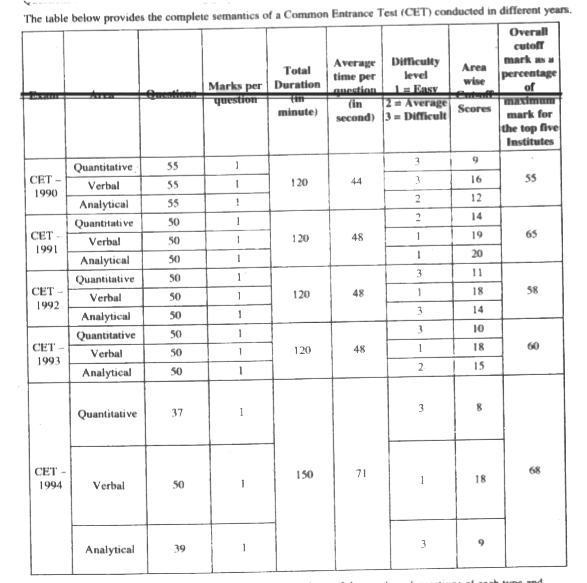What would be the percent growth or birth rate per individual per hour for the same population mentioned in the previous question (Question 10)?
100
200
50
150
The correct Answer is:b
To find the percent growth or birth rate per individual per hour for the given population, we can follow these steps:
1. Identify Initial and Final Population:
- The initial population (at time t1) is given as 50.
- The population after one hour is given as 150.
2. Calculate the Increase in Population:
- The increase in population can be calculated by subtracting the initial population from the final population:
Increase=Final Population−Initial Population=150−50=100
3. Calculate the Birth Rate:
- The birth rate (or growth rate) can be calculated using the formula:
Birth Rate=(Number of New IndividualsInitial Population)×100
- Here, the number of new individuals is the increase we calculated, which is 100. So we substitute this into the formula:
Birth Rate=(10050)×100
4. Perform the Calculation:
- Simplifying the fraction:
10050=2
- Now multiply by 100:
Birth Rate=2×100=200%
5. Conclusion:
- The percent growth or birth rate per individual per hour for the population is 200%.
- The initial population (at time t1) is given as 50.
- The population after one hour is given as 150.
- The increase in population can be calculated by subtracting the initial population from the final population:
Increase=Final Population−Initial Population=150−50=100
- The birth rate (or growth rate) can be calculated using the formula:
Birth Rate=(Number of New IndividualsInitial Population)×100
- Here, the number of new individuals is the increase we calculated, which is 100. So we substitute this into the formula:
Birth Rate=(10050)×100
- Simplifying the fraction:
10050=2
- Now multiply by 100:
Birth Rate=2×100=200%
- The percent growth or birth rate per individual per hour for the population is 200%.
Topper's Solved these Questions
- NCERT Exemplar Questions +2 (MOLECULAR BASIS OF INHERITANCE)BOOK - TRUEMEN BIOLOGY ENGLISHCHAPTER - NCERT Exemplar Questions +2 (MOLECULAR BASIS OF INHERITANCE)EXERCISE - MCQs
28 Videos
- NCERT Exemplar Questions +2 (PRINCIPLE OF INHERITANCE AND VARIATION)BOOK - TRUEMEN BIOLOGY ENGLISHCHAPTER - NCERT Exemplar Questions +2 (PRINCIPLE OF INHERITANCE AND VARIATION)EXERCISE - MCQs
18 Videos
Similar Questions
John rode his bicycle to town at the rate of 15 milles per hour. He left the bicycle in town for minor repairs and walked home along the same route at the rate 3 miles per hour. Excluding the time John spent in taking the bike into the repair shop, the trip took 3 hours. How many hours did John take to walk back?
View SolutionIf birth and death rates were equal, a zero population growth rate would result. It is known as
View Solution
Knowledge Check

By approximatly what percent did the number of questions decrease in CET 1994 over the previous year?A0.16B0.19C0.35D0.4Carmen went on a trip of 120 miles, traveling at an average of x miles per hour. Several days later she returned over the same route at a rate that was 5 miles per hour faster than her previous rate. If the time for the return trip was one-third of an hour less than the time for the outgoing trip, which equation can be used to find the value of x?
A120x+5=13Bx120=x+5120−13C120x+(x−5)=13D120x=120x+5+13A freight train and a passenger train start toward each other at the same time from two towns that are 500 miles apart. After 3 hours, the trains are still 80 miles apart. If the average rate of speed of the passenger train in 20 miles per hour faster than the average rate of speed of the freight train, what is the average rate of speed, in miles per hour, of the freight train?
A40B45C50D60
A popular grows at the rate of 10% of the population per year. How long does it take for the population to doble ?
View SolutionWhat kind of selection is exerted on a population if both the smallest-and largest-sized individuals contribute relatively fewer offspring to the next generation than individuals that are closer to the average size of individuals in the question?
View SolutionIn a population of 2,500 whose intrinsic rate of natural increase (r) is 0.2 per capita per year is exhibiting exponential growth. If the number of individuals at a given moment is 2,000 what will the population size after one year?
View SolutionThe population of a town is increasing at the rate of 5% per annum. What will be the population of the town on this basis after two years, if the present population is 16000?
View SolutionFollowing table summarises the differences between natality and mortality. Select the incorrect ones.
NatalityMortality(i)Natality is number of births per unit population per unit time.It is number of deaths per unit population per unit time.(ii)It adds new individuals to the population.It removes individuals from the population(iii)It increase the size of population.It decreases the size of population(iv)It increase population density.It reduces population density.(v)It is low when population size is small and high when population size is large.It is high when population size is small and low when population size is large.
View Solution
